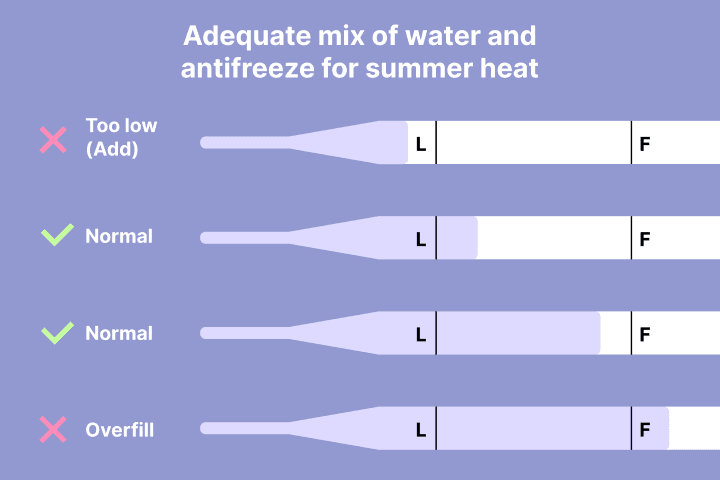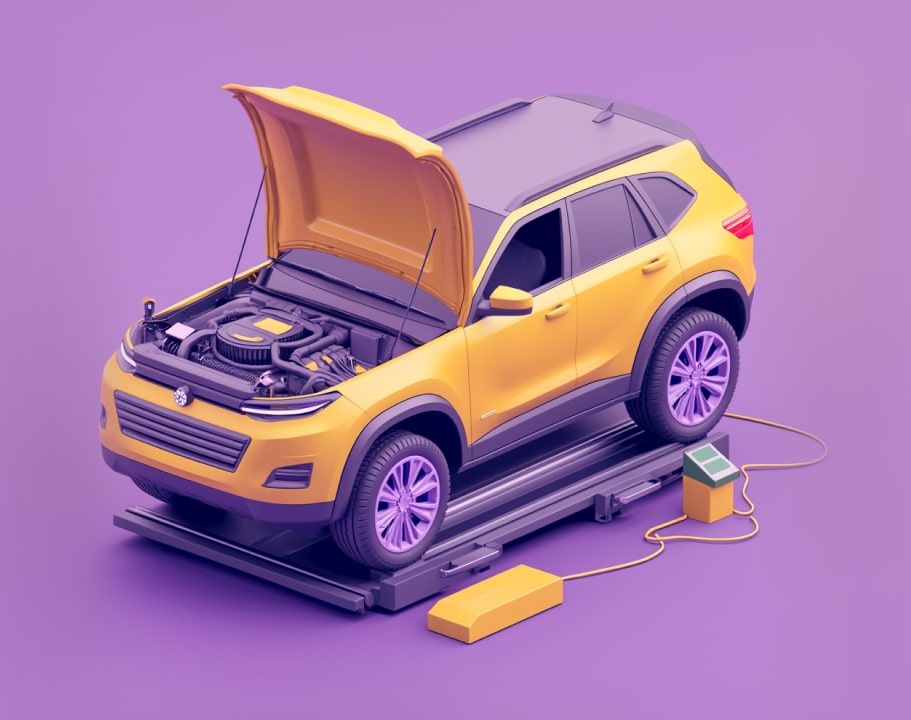Contents
June is here, which means daytime temperatures will rise above 40°C. We’re sure you’ve already put together your summer clothes and skin care products with SPF 50 to prepare for the increased sun exposure. But, as you’re getting ready for the heat, remember that your car needs to be prepped for summer as well.
Getting your vehicle ready for extreme temperatures is no easy task, especially if it’s your first time experiencing them. Luckily, we’ve had some experience with this and, with our seven simple tips, your car will be ready for the heat wave!
Check the engine cooling system
You need to stay hydrated in high temperatures, right? Well, so does your car. So, first things first — check the engine cooling system.
It would be best to take your vehicle to a professional inspection. The mechanic should ensure that the radiator fan is working properly and that cooling hoses are in good condition, without holes or damage. After that, he should check the coolant levels, as they’re essential for protecting your car from overheating.
By the way, you can check the coolant level and fill it up yourself. Just make sure your car is parked on a solid, even ground and that the engine is cold. Then, just pour the coolant in the reservoir up to the ‘FULL’ line.
Finally, if you haven’t flushed the cooling system in the last two to three years, ask the mechanic to do it. This is typically done with distilled water, and you can technically flush your cooling system by yourself, but it’s best to leave it to a professional to avoid the risk of damaging the engine. Also, don’t forget to ask the mechanic to refill the system with an adequate mix of water and antifreeze for summer heat.

Inspect battery health and fluid levels
Heat can also take a toll on the car battery. Ask your mechanic to examine the battery terminals for corrosion and clean them if needed. Moreover, he should check the engine oil level, as high temperatures can thin the motor oil and make it evaporate more quickly.
In addition to engine oil level, ask the mechanic to monitor levels of transmission, brake, and power steering fluids as well.
You can check out both the levels of your fluid and the engine oil level (using the oil level stick) yourself.
Firstly, make sure that the engine is off and on a level surface. Then, find the engine oil dipstick under the hood, wipe it with a cloth, and reinsert it. After a few seconds, pull it back out to see the level the oil reached.
The stick has different lines engraved on it, and the marked “center” of the stick indicates good oil levels. If the oil is barely touching the first level (the one closest to the car) or it’s below it, the level of oil is too low, and you need to add some. In case it’s above the center, there’s too much oil. So, you should remove a bit and repeat the process until the oil level is within the marked center.
But, again, we recommend you leave it to the professional, especially if you have an older model. Sometimes, older parts, especially batteries, cannot endure summer temperatures and require extensive checking. It’s best to know where you stand before the heat waves start.
Check the tires
If you skipped some physics classes at school, you might have missed the lecture about thermal expansion. Basically, it means that air, like any other matter, expands in high temperatures. This simple law of physics can be a lifesaver when driving in summer conditions.
As the temperature rises, the air inside your tires expands, increasing the internal pressure and making them more prone to bursting. Therefore, remember to put summer or all-season tires, and regularly check the air pressure in them.
Also, inspect the tires for any damage or rupture. Finally, consider rotating front and back tires every 8,000 to 10,000 kilometres to ensure even wear.
Don’t forget to check the spare tire as well!
Prepare the air conditioning system
Take your car for a professional A/C inspection before the heat becomes unbearable.
Make sure that the refrigerant is refilled and that the A/C blows cool air. Ask the mechanic to clear or change the cabin air filter to maintain high air quality inside your car.
If you’re more of a DIY type of person, you can change the air filter yourself. The filter is usually located on the front, passenger side of the vehicle, either underneath the glove box, right below it, or inside of it. Google your car model to check the exact location of the cabin air filter.
Then, you should open the cover and carefully remove the filter, making sure that dirt and debris don’t make a mess in your car. After that, simply place the new one in its place and close the cover.
Also, keep in mind — any strange sound or odor coming from the cooling system is a red flag and could indicate problems, such as refrigerant leaks. Make sure to report it to the mechanic.
Clean and wax your car
Washing a car is not only about aesthetics — it’s crucial for protecting your vehicle from damage.
Summer heat can fade and damage the paint. To prevent this, wax your car to add a UV protective layer. Wash it regularly to remove dirt and debris. Moreover, don’t forget to clean the underside and wheel wells to flush dirt and salt.
Clean the interior to reduce dirt buildup and remove any food leftovers, plastic bottles, or flammable objects (such as deodorant and nail polish). We also highly recommend using reflective sunshades on the windshield to lower cabin temperatures and preserve dashboard materials.
Furthermore, don’t forget to check the level of windshield washer fluid (located under the hood) and top it up if needed. Also, take a look at the wiper blades. If they are used up, replace them. Trust us, in case of a sandstorm, you’d want to have new wiper blades and filled up windshield washer fluid.
Prepare an emergency kit
This is an essential tip for all seasons, but it is good to mention it here: always have an updated emergency kit with necessities in your car. These include:
-
Bottled water
-
Non-perishable snacks (such as nuts and dried fruit)
-
Extra clothes and a blanket
-
Flashlight
-
Phone chargers and an external battery
-
Jumper cables
-
Basic car tool kit (with wrench, screwdrivers, rubber mallet, etc)
Just in case, add a Qatar emergency number (999) on speed dial.
Plan for long trips
If you’re planning a longer road trip, define your route while keeping in mind the peak heat hours (typically from 11 AM to 3 PM). Also, check the weather conditions on the entire route. In addition, inform someone about your itinerary and check in with them regularly on your breaks.
Another wise safety tip is to invest in full insurance for car. A comprehensive insurance provides coverage for damages and injuries to you and the passengers in your car for a range of incidents, including fire and theft. We really hope you won't need it, but as the saying goes, better safe than sorry!








